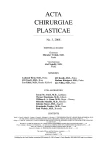PERFORATOR-BASED FOREARM ISLAND FLAP
Autoři:
M. Kateva; K. Dimitrov
Působiště autorů:
Pirogov Hospital for Emergency Medicine, Hand Surgery Department, Sofia, Bulgaria
Vyšlo v časopise:
ACTA CHIRURGIAE PLASTICAE, 50, 3, 2008, pp. 93-94
ANATOMICAL BASIS
In 1997 El-Khatib et al. give proof of the possibility of developing a forearm flap supplied with blood by the perforating branches of the radial artery (3). Five to 11 branches direct themselves superficially through the overlying fascia, the subcutaneous tissue and the skin 2 to 7 cm proximal to the radial styloid. The authors prove that these vessels (0.3–0.9 mm in diameter) provide sufficient blood supply for an area of the forearm skin 5–8 cm wide starting 5–8 cm distal to the intercondilar line of the elbow and accompanying the radial artery distally, reaching the radiocarpal joint. After the flap is rotated it could cover a skin defect in the proximal – of the palm and dorsum of the hand (1, 2).
MATERIALS AND METHOD
The flap is marked longitudinally on the dorsoradial surface of the forearm. Skin and subcutaneous tissue are dissected while care is taken not to harm the superficial branch of the radial nerve. The pedicle is raised in the most atraumatic manner. Its pivot point (point of rotation) is located 3–4 cm proximal to the radial styloid in order to protect the septocutaneous perforator bran-ches. A proper bed is formed for the pedicle through the skin by performing an S-shaped incision. The flap is adapted for and sutured to the recipient site. The donor site is closed primarily. A splint is used for a week in functional position of the radiocarpal joint. The operative procedure takes 1.5 hours.
CASE STUDY
A 45-year-old female presented with post-burn adduction contracture of the thumb (Fig. 1). The flap was dissected at the middle 1/3 of the dorsoradial site of the forearm (Fig. 2). The pivot point is 2 cm proximal to the radial styloid (Fig. 3).



Reconstruction of the cutaneous-subcutaneous defect was achieved, and the contracture was corrected (Fig. 4).

DISCUSSION
Tendons, nerves, joints and bones need to be covered as soon as possible with adequate skin and subcutaneous tissue (2). This is a fundamental requirement in reconstructive surgery. The regional radial forearm flap described by Lu sacrifices the radial artery and leads to cold intolerance of the forearm and hand (6, 7). Groenvelt and Schoorl describe a purely fascial forearm flap, also based on the radial artery (4). Jin’s ulnar retrograde flap sacrifices the ulnar artery (5).
Distant flaps like the groin flap (8) are two-stage procedures. Separation is needed, followed by defatting procedures and late revision for cosmetic reasons. Yang’s free-flap reconstruction (9) is a time-consuming and uncertain procedure which requires a microscope.
Fast and easy dissection in the presented method using magnification up to 3x allows the use of the perforator-based flap in emergency conditions. It is a single-stage operative technique which spares the major arteries and is marked by minimal morbidity of the donor site.
Address for correspondence:
Margarita Kateva, M.D.
Pirogov Hospital For Emergency Medicine,
Hand Surgery Dept.
Totleben 21 blvd.
Sofia1606
Bulgaria
E-mail: mkateff@yahoo.com
Zdroje
1. Baron JN., Emmett AJJ. Subcutaneous pedicle flaps. Br. J. Plast. Surg., 18, 1965, p. 51.
2. Cormack G., Lamberty B. The arterial anatomy of skin flaps. London: Churchill Livingstone, 1986, p. 91–112.
3. El-Khatib H., Zeidan M. Island adipofascial flap based on distal perforators of the radial artery: an anatomic and clinical investigation. Plast. Reconstr. Surg., 100, 1997, p. 1762–1766.
4. Groenvelt F., Schoorl R. The reversed forearm flap using scarred skin in hand reconstruction. Br. J. Plast. Surg., 38, 1985, p. 398.
5. Jin Y-T., Guan W-X., Shi T-M., Xu L-G., Chang TS. Reversed island forearm fascial flap in hand surgery. Ann. Plast. Surg., 15, 1985, p. 340.
6. Lu KH., Zhung DC., Chen B., Luo JW. The clinical applications of the reversed forearm island flap. Chin. J. Surg., 20, 1982, p. 695.
7. Martin D., Casoli V. Reconstruction of the hand with forearm island flaps. Clin. Plast. Surg., 24, 1997, p. 33–48.
8. McGregor IA., Jackson IT. The groin flap. Br. J. Plast. Surg., 25, 1972, p. 3.
9. Yang G. et al. Forearm free skin flap transplantation. Natl. Med. J. China, 16, 1987, p. 139.
Štítky
Chirurgie plastická Ortopedie Popáleninová medicína TraumatologieČlánek vyšel v časopise
Acta chirurgiae plasticae

2008 Číslo 3
- Metamizol jako analgetikum první volby: kdy, pro koho, jak a proč?
- Primární prevence osteoporózy v kostce
- Neodolpasse je bezpečný přípravek v krátkodobé léčbě bolesti
- Léčba akutní pooperační bolesti z pohledu ortopeda
Nejčtenější v tomto čísle
- ČESKÉ SOUHRNY
- SYNMASTIA – AN UNUSUAL COMPLICATION OF AUGMENTATION MAMMAPLASTY
- CLINICAL EFFICACY OF A NEW CHITIN NANOFIBRILS-BASED GEL IN WOUND HEALING
- NEUROCUTANEOUS METACARPAL FLAPS
